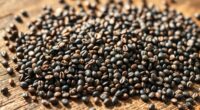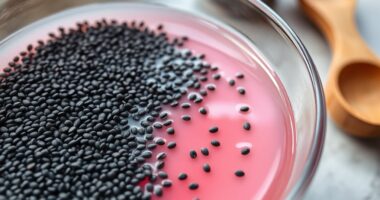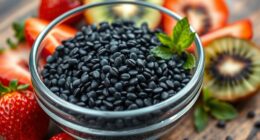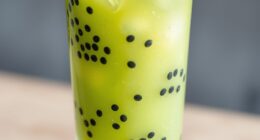To use chia seeds as an egg substitute, grind 1 tablespoon of chia seeds and mix with 3 tablespoons of water for each egg you need. Let the mixture sit for 5-10 minutes until it forms a gel. This gel adds moisture and acts as a binder in recipes like muffins or cookies. If you’d like to find out more tips and tricks, keep exploring how to make the most of this versatile ingredient.
Key Takeaways
- Mix 1 tablespoon ground chia seeds with 3 tablespoons water per egg and let sit for 5-10 minutes until gelled.
- Adjust quantities based on the number of eggs your recipe requires, multiplying ratios accordingly.
- Use chia eggs in muffins, cookies, pancakes, and bread for binding and moisture without leavening effects.
- Grind chia seeds if needed, then combine with water to create a nutrient-rich, egg-like binder for vegan baking.
- Note that chia eggs may slightly alter texture and color, making baked goods denser and more moist.
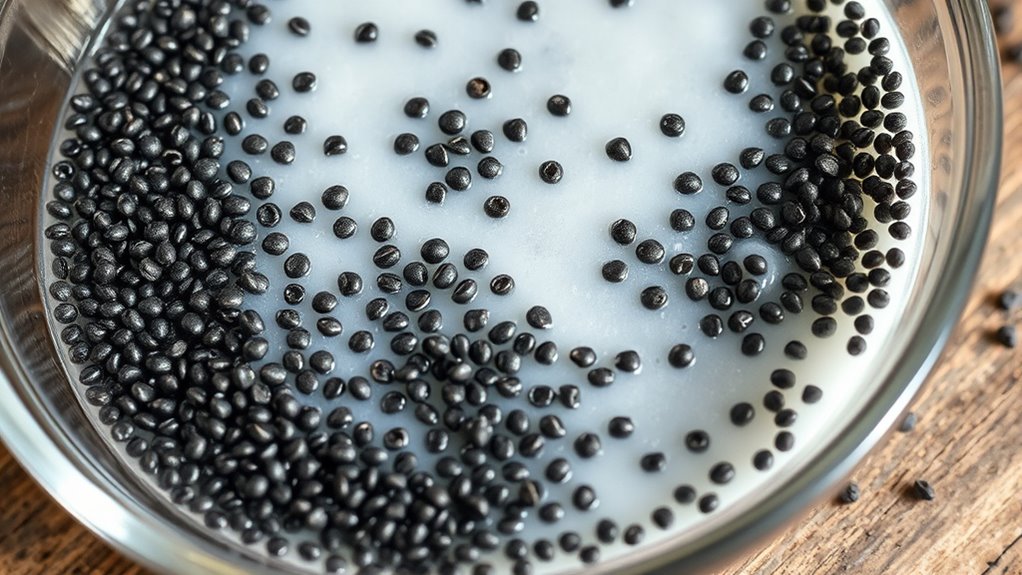
If you’re looking for a plant-based or allergy-friendly way to replace eggs in your recipes, chia seeds offer an excellent solution. They’ve become a popular ingredient in vegan baking because of their ability to mimic the binding and moisture-retaining qualities of eggs. Using chia seeds as an egg substitute is simple: you just need to create a chia “egg” by mixing ground chia seeds with water. Typically, one tablespoon of ground chia seeds combined with three tablespoons of water creates a gel-like consistency that’s perfect for baking. This mixture is often called a “chia egg” and works well in muffins, pancakes, cookies, and bread.
Chia seeds create a versatile, plant-based egg substitute ideal for vegan baking.
The process is quick—just grind the chia seeds if they aren’t already ground, then stir them into the water and let the mixture sit for about 5-10 minutes. During this time, the seeds absorb the water and form a thick, viscous gel. This gel acts as a binder, helping to hold your baked goods together just like a traditional egg would. It’s especially effective in recipes where eggs are mainly used for structure and moisture, rather than for leavening. If you need to replace multiple eggs, simply multiply the chia seed and water proportions accordingly. For instance, for two eggs, use two tablespoons of ground chia seeds and six tablespoons of water.
Vegan baking has gained popularity not just because it suits dietary restrictions but also because of the nutritional benefits chia seeds bring to the table. These tiny seeds are packed with fiber, omega-3 fatty acids, protein, vitamins, and minerals like calcium and magnesium. Incorporating chia seeds into your baking not only helps you avoid eggs but also boosts the nutritional profile of your treats. Plus, they add a slight nutty flavor and a pleasant crunch if you don’t grind them, offering a subtle texture contrast.
Using chia seeds as an egg substitute is versatile and cost-effective. They perform especially well in recipes that don’t rely heavily on eggs for rising or leavening, but rather for binding and moisture. Keep in mind that chia eggs may slightly alter the texture and color of baked goods, giving them a denser or more moist crumb. However, if you’re seeking an allergy-friendly or vegan alternative that also enhances your baked goods’ nutritional value, chia seeds are an unbeatable choice. They’re easy to prepare, healthy, and adaptable, making them a staple for anyone looking to make their baking more plant-based and wholesome. Additionally, self watering plant pots are a great example of how innovative solutions can help maintain consistent moisture levels, much like how chia seeds help retain moisture in baked goods.
Frequently Asked Questions
Can Chia Seeds Replace Eggs in All Types of Baking?
Chia seeds can often replace eggs in baking, especially in recipes like muffins, pancakes, and cookies, but they might not work for all types. Their nutritional benefits include omega-3s, fiber, and protein, making your baked goods healthier. Store chia seeds in an airtight container in a cool, dark place to maintain freshness. Keep in mind, their binding properties may vary, so experiment to find the best use for your recipes.
How Does Chia Seed Substitution Affect Baked Goods’ Texture?
Think of chia seeds as a magic wand for your baked goods, transforming their texture. When you substitute eggs with chia seeds, you’ll notice a slight texture variation—sometimes a bit more gelatinous—due to their moisture retention. This change can make your treats moister and chewier, but it may also add a tiny bit of crunch. Overall, chia seeds help maintain a tender, moist crumb, enhancing your baked creations.
Are There Any Flavor Changes When Using Chia Seeds?
When you use chia seeds as an egg substitute, you might notice a slight flavor impact. Chia seeds have a mild, nutty taste that can alter the overall flavor of your baked goods. This taste alteration is usually subtle, but it can add a unique dimension to recipes. Overall, most people find that chia seeds don’t markedly change the flavor, making them a versatile and healthy egg alternative.
How Long Does It Take for Chia Seeds to Gel?
Imagine you’re in the age of dial-up internet, waiting patiently for a connection. When using chia seeds as an egg substitute, you’ll notice they take about 15 minutes of soaking time to reach a gel consistency. During this period, the seeds absorb liquid and create a thick, pudding-like texture ideal for baking. Keep in mind, the gel consistency forms gradually, so patience is key to achieving the perfect result.
Can Chia Seeds Be Used as an Egg Substitute in Savory Recipes?
Yes, you can use chia seeds as an egg substitute in savory dishes for eggless cooking. When making savory recipes, mix 1 tablespoon of ground chia seeds with 3 tablespoons of water and let it sit until it gels. This chia gel adds moisture and binds ingredients like eggs do, making it perfect for veggie patties, quiches, or casseroles. It’s a versatile, plant-based option for egg-free savory dishes.
Conclusion
Now that you know how to turn chia seeds into an egg substitute, you’re ready to experiment in the kitchen. Think of it like planting a tiny seed that grows into a delicious cake or fluffy pancake—your baking garden flourishing with a simple swap. I once replaced eggs in a recipe and watched it rise just as beautifully, proving that small changes can lead to big results. So go ahead, give it a try and see your baking bloom!

